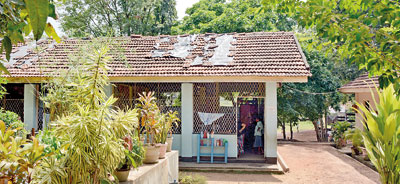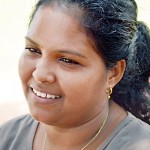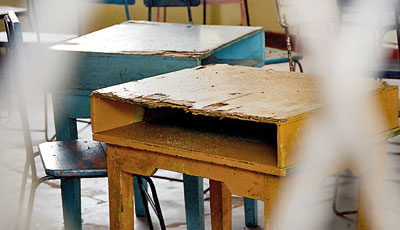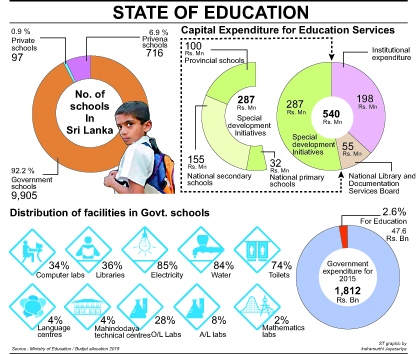News
Schools for scandal
No toilets, no water, crumbling furniture and parents foot government bills. Education levels suffer while the Minister talks of a three-year plan. Aanya Wipulasena reports
on the mess in our schools
Nine-year-old Nethmi Sathsarani* does not like to go to school on rainy days because its tile roof leaks, soaking her books and bag.
She hates it even more because the mist that comes in through the open windows makes her sick. This means that she will have to stay home for a couple of days until she feels better.
Sri Lanka boasts of free education and school development projects but in most parts of the country free education comes with an inevitable price.
Lack of basic facilities such as drinking water, electricity, toilet facilities, playgrounds, usable furniture and even teachers plague these schools where thousands of students go to study. Research has shown that these facilities are needed as a vital precondition for students’ educational

Polythene sheets to cover up a leaking roof and below dilapidated desks. Pix by M.D. Nissanka
development, helping them to focus more in studies.
Last year, 43 per cent of Ordinary Level candidates failed in mathematics, 52 per cent failed in English and 14 per cent in Sinhala language and literature.
Schools even in the heart of the Western Province are not immune from the lack of necessary facilities.
Sathsarani is among 300 students of the Agramathya Vidyalaya, a primary school in Thalawathugoda. It is nearly 120 years old and was primarily opened as a maha vidyalaya, with grade one to 11 classes but was later converted to a primary school. At one point, in 2003, the school had only one student as most had left due to the school’s bad state.
Now, even from a distance one can easily see its tiled roof covered with black polythene. These have been laid by parents in the hope of stopping the roof from leaking when it rains.
The school consists of four decaying buildings. One is recently roofed with asbestos sheets given by the state but others remain in their sad state. Peeling paint and furniture with holes are among many other discomforts students are greeted with every morning.

Kusumalatha Perera
“Students use the same toilets and buildings we used nearly 30 years ago. They are very old and leaks all the time,” said Kusumalatha Perera whose daughter studies in grade three at the school. She said that sometimes parents fear sending their children to school because the wood that is holding the roof is old and decaying.
The school has only eight teachers including the one who teaches English. This teacher is also working at the Education Ministry which allows him only two days to come and take classes in the school.
“Even the dancing teacher is a student of the Visual and Performing Arts University in Colombo. We collect Rs. 50 each from parents every month to pay her. The school has computers but no teacher to teach IT,” said Kusum Perera, a mother of two and secretary of the school development committee.
Mrs. Perera added that as a result of the leaking roof the students are made to carry their books back home every day because they cannot leave them in the class cupboards which are also in bad condition with mites eating into the wood.

Kusumalatha Perera
“We even got together and filled the holes in the class floors recently. They were in a really bad state. Students couldn’t even sit properly because of these potholes,” she added.
Anusha Dilrukshi, a resident of Thalawathugada whose daughter studies in grade three, said the furniture used by the students had been rejected by another school.
“Our children can’t study like this. The parents are doing their best to make it more comfortable for them,” she said.
Schools in other provinces are in a more appalling state. St Luke’s College and Mihindu Vidyalaya in Ratnapura, considered to be two of the few popular schools in the Sabaragamuwa Province, have badly-maintained toilets, very old furniture and overcrowded classrooms, and both schools lack playgrounds.
President Rajapaksa recently declared sports to be a compulsory subject for all school students from next year. According to the Minister of Sports, Mahindananda Aluthgamage, only 5 per cent of primary students, 2 per cent of those in the Ordinary Level classes and 0.2 per cent of Advanced Level students take part in sport activities – and a large number of schools lack a playground.
 Schools such as Aselapura Maha Vidyalaya in Polonnaruwa are among many in the North Central, Uva and Southern Provinces where students do not have access to drinking water, especially during drought periods.
Schools such as Aselapura Maha Vidyalaya in Polonnaruwa are among many in the North Central, Uva and Southern Provinces where students do not have access to drinking water, especially during drought periods.
Even though major problems continue to exist in our schools teachers and principals are not willing to freely disclose the matter as the Ministry of Education has issued a circular ordering them to obtain approval before talking to the media.
“Teachers are not allowed to talk but it can be clearly seen that school resources are not equally distributed. Students who go to the ‘popular schools’ get everything. Schools in villages do not have enough furniture and most that they have are not in good condition,” said the Sri Lanka Teachers Union General Secretary, Joseph Stalin.
He added that for the next year the government allocated a total of Rs. 47.6 billion as expenditure for education and Rs. 17.1bn as the capital from which a sum of Rs. 11.2bn would be spent on the Mahindodaya 1000 school project.
“There are 9,905 schools in Sri Lanka and the government is only focusing on developing 1,000 schools. What is going to happen to the rest of them?” questioned Mr. Stalin. “Today the state is only paying for half of the school electricity and parents are made to pay for the other half.
“Parents have to spend on school expenses in some form. This is not free education,” Mr. Stalin added.
According to statistics by the Ministry of Education, by 2013 only 34 per cent of state-run schools had computer laboratories, 36 per cent had libraries and 74 per cent had toilet facilities. In addition to this 15 per cent did not have electricity and 16 per cent lacked access to water.
Minister of Education Services Duminda Dissanayake told the Sunday Times the government wished to distribute furniture to all government schools in three years. He said that they are currently collecting information for the project.
“Rs. 1, 207 million was allocated in the Budget to provide furniture to both national and provincial schools in the country. An additional Rs. 162 million was allocated for toilet and drinking water facilities to schools which lack them,” the Minister said adding that there was a three-year plan to provide the necessary facilities.
*Name changed to protect identity.

